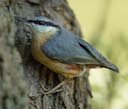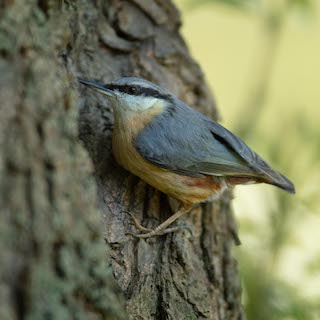 Nuthatches fiercely defend their nesting sites. A bird of broadleaf woodlands, it is also a frequent visitor to garden birdfeeders.
Nuthatches fiercely defend their nesting sites. A bird of broadleaf woodlands, it is also a frequent visitor to garden birdfeeders.
Photo: © Richard Birchett
Scientific name: Sitta europaea
Other common names: Eurasian Nuthatch
UK conservation status: Green
What to look for:
• Colouring and appearance: A distinctive black eye stripe in males, or dark-brown in females; chestnut-coloured sides, blueish-grey above, and white below. A small bird with a pointed black bill and short legs.
• Size: Wingspan, 24 cm; length 14 cm.
• Where: Mature broadleaf woodlands and parkland across England and Wales; occasionally in southern Scotland.
• Call: A ‘dwip-dwip’ call
 The main food of the Nuthatch is, in fact, insects, not nuts. In autumn and winter, however, it also eats acorns and beechmast, as well as other nuts and seeds. The Nuthatches wedges larger nuts in crevices, and then uses its tough bill to hammer them open. It is a very agile bird, so look for it using its powerful toes to climb down tree trunks head-first, or hanging upside down from branches, as it probes the bark for insect prey. They’ll often eat in that position, too. Nuthatch pairs diligently store food, and fiercely defend their territory, both to protect their young in the nesting season, and to guard against food thieves. They are remarkably faithful to their territory: in the UK, no ringed individual has been found to travel for further than 1 km.
The main food of the Nuthatch is, in fact, insects, not nuts. In autumn and winter, however, it also eats acorns and beechmast, as well as other nuts and seeds. The Nuthatches wedges larger nuts in crevices, and then uses its tough bill to hammer them open. It is a very agile bird, so look for it using its powerful toes to climb down tree trunks head-first, or hanging upside down from branches, as it probes the bark for insect prey. They’ll often eat in that position, too. Nuthatch pairs diligently store food, and fiercely defend their territory, both to protect their young in the nesting season, and to guard against food thieves. They are remarkably faithful to their territory: in the UK, no ringed individual has been found to travel for further than 1 km.
Nuthatches nest in tree cavities, often utilising old woodpecker holes, up to 20 m above ground level. The entrance is sometimes smeared with mud if the pair think it is too large (and therefore less defensible). Inside, the nest cavity is layered with woodchips to cover and protect the egg and hatchlings if the adults are away foraging. Eggs are speckled red, usually in clutches of up to nine (sometimes two clutches per year), with incubation by the female for up to 18 days. Both parents share parental feeding duties.
Did you know…?
…There are 24 different Nuthatch species globally.
…It is the only tree-climbing bird in the UK that can climb down trees head-first, thanks to its strong grip.
More information and references:
Svensson, L., Mullarney, K., Zetterstrom, D.,1986. Collins Bird Guide, second edition (translated by Christie, D., Svensson, L.). HarperCollins, London.
Published: April 2020
Author: Amanda Scott
Photos: © Richard Birchett
